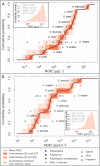Toward an ecotoxicological risk assessment of microplastics: Comparison of available hazard and exposure data in freshwaters
- PMID: 30488983
- PMCID: PMC6849787
- DOI: 10.1002/etc.4323
Toward an ecotoxicological risk assessment of microplastics: Comparison of available hazard and exposure data in freshwaters
Abstract
Microplastics have been detected in freshwaters all over the world in almost all samples, and ecotoxicological studies have shown adverse effects of microplastics on organisms. However, no risk assessment of microplastics has been performed specifically in freshwater so far. The aim of the present study was therefore to review all exposure and ecotoxicity data available for microplastics in freshwaters and to perform a preliminary probabilistic risk assessment. The exposure probability distribution was based on 391 concentrations measured in Asia, Europe, and North America. Because exposure data are mainly available in particle number-based metrics but results from hazard studies are mostly mass-based, the hazard results were converted into particle number concentrations. A statistical analysis of the hazard data showed that there was no significant influence of particle shape or type of polymer on the no-observed-effect concentration. The predicted-no-effect concentration (PNEC) was calculated as the fifth percentile of the probabilistic species sensitivity distribution, based on 53 values from 14 freshwater species, to have a mode of 7.4 × 105 particles · m-3 (25th and 75th quantiles of 6.1 × 105 and 1.3 × 106 particles · m-3 , respectively). The exposure probability distribution was divided by the PNEC probability distribution to calculate risk characterization ratios (RCRs), with modes of 1.3 × 10-6 in North America, 3.3 × 10-6 in Europe, and 4.6 × 10-3 in Asia. Probability distributions associated with the RCRs showed that ecological risks cannot be entirely excluded in Asia, where 0.4% of the RCR values were above 1. Environ Toxicol Chem 2019;38:436-447. © 2018 SETAC.
Keywords: Freshwater; Microplastics; Probabilistic risk assessment; Probabilistic species sensitivity distribution.
© 2018 SETAC.
Figures







Similar articles
-
A Meta-analysis of Ecotoxicological Hazard Data for Nanoplastics in Marine and Freshwater Systems.Environ Toxicol Chem. 2020 Dec;39(12):2588-2598. doi: 10.1002/etc.4887. Epub 2020 Nov 10. Environ Toxicol Chem. 2020. PMID: 33002218 Free PMC article.
-
Probabilistic environmental risk assessment of microplastics in marine habitats.Aquat Toxicol. 2021 Jan;230:105689. doi: 10.1016/j.aquatox.2020.105689. Epub 2020 Nov 25. Aquat Toxicol. 2021. PMID: 33302173
-
Meta-analysis of the hazards of microplastics in freshwaters using species sensitivity distributions.J Hazard Mater. 2024 Feb 5;463:132919. doi: 10.1016/j.jhazmat.2023.132919. Epub 2023 Nov 4. J Hazard Mater. 2024. PMID: 37944233
-
Microplastics in freshwater systems: a review of the emerging threats, identification of knowledge gaps and prioritisation of research needs.Water Res. 2015 May 15;75:63-82. doi: 10.1016/j.watres.2015.02.012. Epub 2015 Feb 17. Water Res. 2015. PMID: 25746963 Review.
-
Microplastics in freshwater ecosystems: probabilistic environmental risk assessment and current knowledge in occurrence and ecotoxicological studies.Environ Toxicol Chem. 2025 Jan 1;44(1):3-25. doi: 10.1093/etojnl/vgae008. Environ Toxicol Chem. 2025. PMID: 39887287 Review.
Cited by
-
Microplastics: A Matter of the Heart (and Vascular System).Biomedicines. 2023 Jan 18;11(2):264. doi: 10.3390/biomedicines11020264. Biomedicines. 2023. PMID: 36830801 Free PMC article. Review.
-
Preliminary screening of microplastic contamination in different marine fish species of Taif market, Saudi Arabia.Open Life Sci. 2022 Apr 6;17(1):333-343. doi: 10.1515/biol-2022-0034. eCollection 2022. Open Life Sci. 2022. PMID: 35480485 Free PMC article.
-
Effects of microplastics and natural particles on the aquatic invertebrate Daphnia magna under different dietary quality scenarios.Oecologia. 2025 May 14;207(6):81. doi: 10.1007/s00442-025-05723-2. Oecologia. 2025. PMID: 40369333
-
Currently monitored microplastics pose negligible ecological risk to the global ocean.Sci Rep. 2020 Dec 17;10(1):22281. doi: 10.1038/s41598-020-79304-z. Sci Rep. 2020. PMID: 33335221 Free PMC article.
-
A Meta-analysis of Ecotoxicological Hazard Data for Nanoplastics in Marine and Freshwater Systems.Environ Toxicol Chem. 2020 Dec;39(12):2588-2598. doi: 10.1002/etc.4887. Epub 2020 Nov 10. Environ Toxicol Chem. 2020. PMID: 33002218 Free PMC article.
References
-
- Avio CG, Gorbi S, Regoli F. 2015. Experimental development of a new protocol for extraction and characterization of microplastics in fish tissues: First observations in commercial species from Adriatic Sea. Mar Environ Res 111:18–26. - PubMed
-
- Baldwin AK, Corsi SR, Mason SA. 2016. Plastic debris in 29 Great Lakes tributaries: Relations to watershed attributes and hydrology. Environ Sci Technol 50:10377–10385. - PubMed
-
- Blettler MCM, Abrial E, Khan FR, Sivri N, Espinola LA. 2018. Freshwater plastic pollution: Recognizing research biases and identifying knowledge gaps. Water Res 28:416–424. - PubMed
-
- Burns E, Boxall ABA. 2018. Microplastics in the aquatic environment: Evidence for or against adverse impacts and major knowledge gaps. Environ Toxicol Chem 37:2776–2796. - PubMed
-
- Cable RN, Beletsky D, Beletsky R, Wigginton K, Locke BW, Duhaime MB. 2017. Distribution and modeled transport of plastic pollution in the Great Lakes, the world's largest freshwater resource. Front Environ Sci 5 DOI: 10.3389/fenvs.2017.00045. - DOI
MeSH terms
Substances
LinkOut - more resources
Full Text Sources

